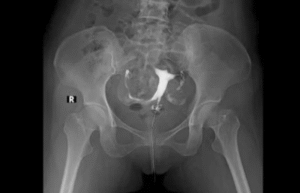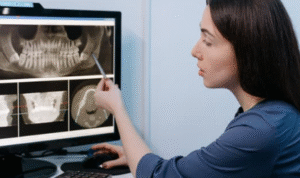A Hysterosalpingogram (HSG) is a specialized X-ray procedure commonly used in fertility clinics to evaluate the structure and patency (openness) of a woman’s uterus and fallopian tubes. This diagnostic test plays a vital role in assessing fertility issues and determining potential causes of infertility, such as blocked fallopian tubes or uterine abnormalities.
The HSG test is performed using a contrast dye that outlines the inner shape of the uterus and fallopian tubes, allowing healthcare professionals to identify structural problems that may be interfering with conception. While the procedure is relatively quick, many women have concerns about HSG test pain, potential side effects, and what to expect during and after the test.
In this comprehensive guide, we’ll delve deep into the technical aspects of the HSG test, how to prepare, what happens during the procedure, and the possible side effects, including detailed insights into post-procedure symptoms and potential complications.
What Is a Hysterosalpingogram (HSG) Test?

A Hysterosalpingogram (HSG) is a radiographic procedure that uses fluoroscopy (a continuous X-ray beam) and a radiopaque contrast dye to visualize the internal structure of the uterus and fallopian tubes. The dye, which contains iodine, is introduced into the uterine cavity through the cervix using a catheter. The purpose of the dye is to outline the shape of the uterine cavity and trace the patency of the fallopian tubes.
Why Is the HSG Test Important?
The HSG test is primarily performed to investigate issues related to infertility. Blocked fallopian tubes or uterine anomalies, such as adhesions or scarring, can hinder the sperm’s ability to reach the egg or the fertilized egg’s passage to the uterus. The HSG test helps in diagnosing the following conditions:
- Tubal Blockages: Often caused by pelvic inflammatory disease (PID), endometriosis, or previous surgeries.
- Uterine Anomalies: Such as septate uterus, bicornuate uterus, or polyps.
- Adhesions or Scarring: Resulting from infections or surgical procedures.
- Tubal Patency: To determine whether the tubes are open or blocked.
- Post-Surgical Assessment: To check the success of procedures like tubal ligation reversal.
The HSG test is crucial in fertility assessments because it provides real-time imaging of how the contrast dye moves through the uterus and fallopian tubes, highlighting any blockages or abnormalities.
When Is the HSG Test Performed?
The ideal time for performing an HSG test is typically between days 7 to 10 of the menstrual cycle. This timing ensures that:
- The uterus lining is thin, allowing for clear imaging.
- The possibility of pregnancy is minimized.
- Any active menstrual bleeding has ceased, reducing the risk of contamination.
It’s essential to follow your healthcare provider’s advice regarding the timing, as the HSG test should not be performed if there is a chance of pregnancy.
Technical Aspects of the HSG Test
Equipment Used
The HSG test requires specialized imaging equipment and contrast agents, including:
- Fluoroscopy Unit: Provides real-time X-ray imaging.
- Radiopaque Contrast Dye: Usually an iodine-based solution that highlights internal structures.
- Speculum: To open the vaginal canal and access the cervix.
- Catheter: A thin, flexible tube for injecting the dye.
Radiographic Technique

The HSG test involves fluoroscopic imaging to visualize the movement of the contrast dye through the reproductive organs. Real-time X-ray images are captured as the dye flows from the uterus through the fallopian tubes and potentially spills into the pelvic cavity, indicating tubal patency.
Contrast Dye Characteristics
The contrast dye used in HSG tests is typically iodine-based because iodine absorbs X-rays well, appearing white on radiographic images. This high contrast allows for detailed visualization of the uterine cavity and fallopian tubes.
How to Prepare for the HSG Test?
Proper preparation for the HSG test can help minimize discomfort and reduce the risk of complications. Here’s what you should do before the procedure:
Medical Preparation
- Antibiotic Prophylaxis: Some healthcare providers prescribe antibiotics to minimize the risk of pelvic infections.
- Pain Management: Taking an over-the-counter NSAID (like ibuprofen) about an hour before the test can reduce cramping.
- Inform About Allergies: Let your healthcare provider know if you have a known allergy to iodine or contrast media.
Physical Preparation
- Personal Hygiene: Avoid using tampons, douches, or vaginal medications before the procedure.
- Dietary Restrictions: Generally, no fasting is required, but follow your doctor’s advice.
- Comfortable Clothing: Wear loose-fitting attire that’s easy to change.
Emotional and Mental Preparation

The HSG test may cause anxiety due to the anticipation of pain or discomfort. Speaking to your healthcare provider about your concerns can help alleviate stress. Some women may choose to take a mild sedative if recommended by their physician.
Procedure: How the HSG Test Is Done?
The HSG test typically follows these steps:
- Positioning: You will lie on your back with your legs bent and feet in stirrups, similar to a pelvic exam.
- Speculum Insertion: A speculum is inserted into the vagina to visualize the cervix.
- Cervical Cleaning: The cervix is cleaned with an antiseptic solution.
- Catheter Insertion: A thin catheter is gently inserted into the cervical canal.
- Contrast Dye Injection: The dye is slowly injected through the catheter into the uterine cavity.
- Fluoroscopic Imaging: X-ray images are taken to observe the flow of the dye through the uterus and fallopian tubes.
- Evaluation: If the dye freely spills into the pelvic cavity, the tubes are open. If not, a blockage may be present.
Is the HSG Test Painful?
One of the most common questions is whether the HSG test is painful. The level of discomfort varies, but most women experience mild to moderate cramping during the dye injection. The cramping sensation is similar to intense menstrual cramps and usually lasts only a few minutes.
Factors influencing pain include:
- Presence of Tubal Blockage: Blocked tubes may cause increased pressure and pain.
- Personal Pain Tolerance: Some women report minimal discomfort, while others find it more intense.
- Anxiety and Stress Levels: Nervousness can heighten the perception of pain.
Possible Side Effects of the HSG Test
While the HSG test is generally safe, it can cause several side effects, including:
- Cramping and Pain: Usually mild and short-lived.
- Spotting or Light Bleeding: Expected for a day or two post-procedure.
- Allergic Reaction: Rare but can occur if sensitive to the dye.
- Infection: Signs include fever, foul-smelling discharge, and severe pain.
- Lower Abdominal Pain: Typically subsides within a few hours to a day.
Post-Procedure Care
After the HSG test, you may experience:
- Vaginal Discharge: The contrast dye and slight bleeding may persist for a day.
- Cramps and Discomfort: Over-the-counter pain relievers can help.
- Monitoring for Complications: Watch for signs of infection, such as fever or heavy bleeding.
When to Seek Medical Attention?
Contact your healthcare provider immediately if you experience:
- Severe abdominal pain or cramping
- Heavy vaginal bleeding
- High fever or chills
- Foul-smelling vaginal discharge
Is the HSG Test Safe?
The HSG test is considered a safe diagnostic procedure with a low complication rate. However, it’s crucial to discuss your medical history and any potential allergies with your healthcare provider before undergoing the test.
Risks of the HSG Test
- Infection: Pelvic infections occur in less than 1% of cases.
- Allergic Reaction: To the iodine-based contrast dye.
- Uterine Injury: Rare but can occur during catheter insertion.
- Radiation Exposure: Minimal and comparable to a standard X-ray.
By understanding the technical details and preparation involved in the HSG test, women can approach the procedure with confidence and awareness. Always follow your healthcare provider’s instructions and report any unusual symptoms immediately after the procedure.
FAQ – Hysterosalpingogram: How to Prepare, What to Expect, and Side Effects of the HSG Test
What should I avoid after HSG?
After an HSG test, it is crucial to take certain precautions to minimize the risk of infection and discomfort:
- Avoid Sexual Intercourse: Refrain from sexual activity for at least 48 hours to reduce the risk of infection.
- No Tampons: Use sanitary pads instead of tampons to manage any spotting or discharge.
- No Douching: Avoid vaginal douching as it can introduce bacteria and increase the risk of pelvic infections.
- Physical Activities: Limit strenuous activities, heavy lifting, and intense workouts for a day or two.
- Bathing Precautions: Opt for showers instead of baths for at least 48 hours.
If you experience severe pain, heavy bleeding, or foul-smelling discharge after the procedure, contact your healthcare provider immediately.
Can one conceive immediately after HSG test?
Yes, some women do report conceiving shortly after undergoing an HSG test. This is because the dye used during the procedure may help flush out minor blockages in the fallopian tubes, thereby increasing the chances of conception. Studies have shown a slight increase in pregnancy rates within three to six months after the HSG test, particularly when an oil-based contrast dye is used.
However, it is important to remember that not all women will experience enhanced fertility after the procedure, and the effectiveness largely depends on the underlying fertility issues being addressed.
What are the side effects of tubal flushing?
Tubal flushing, which is essentially the injection of contrast dye during an HSG test, may cause several side effects:
- Cramping and Discomfort: Similar to menstrual cramps, usually subsiding within a few hours.
- Vaginal Spotting: Light bleeding or spotting is common after the procedure.
- Lower Abdominal Pain: Some women may experience mild to moderate pain for a day or two.
- Infection: In rare cases, tubal flushing can introduce bacteria into the reproductive tract, leading to pelvic inflammatory disease (PID).
- Allergic Reaction: Although uncommon, some women may have an allergic response to the iodine-based contrast dye.
If you experience symptoms like high fever, foul-smelling vaginal discharge, or severe abdominal pain, seek medical attention immediately.
What is the 10-day rule for HSG?
The 10-day rule for HSG refers to performing the procedure within the first 10 days after the onset of menstruation. This guideline ensures that:
- The uterine lining is thinner, making it easier to obtain clear images.
- There is a minimal chance of pregnancy, as ovulation typically occurs later in the cycle.
- Any menstrual bleeding has stopped, reducing the risk of contamination during the procedure.
This rule is essential for maintaining safety and accuracy, as performing an HSG during or after ovulation may inadvertently expose an early pregnancy to radiation.
Can HSG give wrong results?
Yes, an HSG test can sometimes produce false-positive or false-negative results. Some common reasons include:
- Tubal Spasms: These can temporarily block the flow of dye, mimicking a tubal blockage.
- Insufficient Dye Injection: Inadequate dye may not reach the tubes, giving the false impression of blockage.
- Technical Errors: Improper catheter placement or suboptimal imaging techniques can affect the accuracy.
- Residual Inflammation: Previous infections or surgeries can cause adhesions that mimic blockages.
To confirm suspicious results, doctors may recommend follow-up tests like laparoscopy or sonohysterography.




